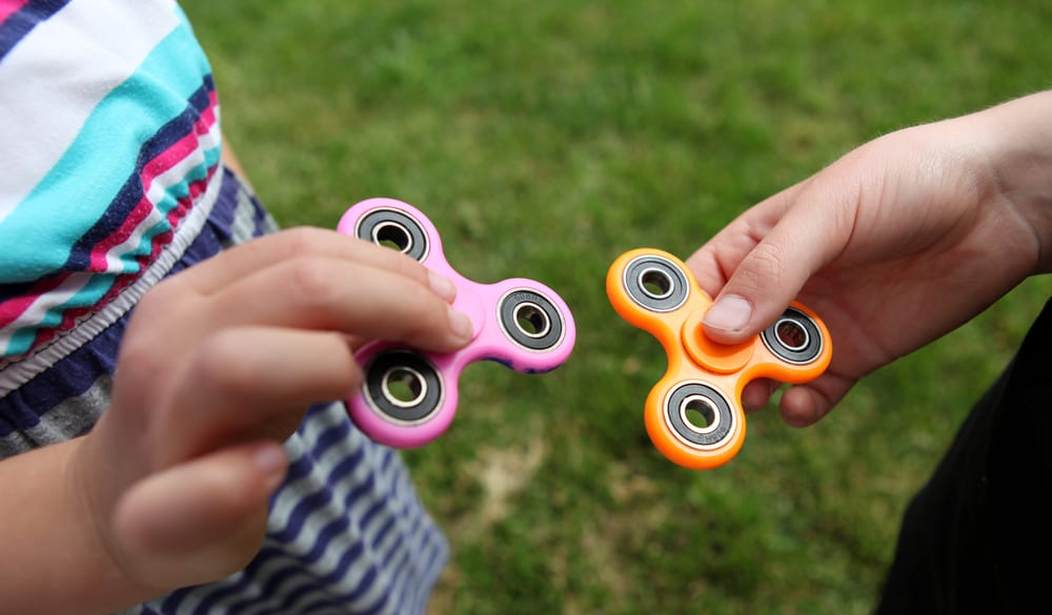If you have had any interaction with elementary or middle school-aged children over the last year, you’ve likely been bombarded with the thumping of a partially-filled plastic water bottle, the clicking of a fidget toy, and probably have encountered a mess or two in your kitchen sink involving slime made from glue and Borax. If you haven’t run into this sensory overload of current childhood crazes, you probably homeschool your children. So what’s the big deal? Why are these trends and obsessions taking hold? And why are so many parents and educators hell-bent on banning them?
In my household, my ten-year-old began bottle flipping about six months ago. I think he was a bit late to the party on that one, but the fad was going strong for a while. We even turned his trendy obsession into his school science fair project. We had fun with it. We learned about physics and he learned how to conduct repetitive variable experiments. Sure, the constant “thump, thump, thump” followed by groans of frustration can totally get to a parent, but I can think of worse things for my kid to be spending time on.
Next to make an appearance in our neighborhood was actually a revival—of the Rubik’s Cube. With the ease of access to YouTube and a plethora of how-to videos, my kids and their friends would challenge each other by mixing up their three-by-three cubes and passing them around to get solved. One of my neighbors’ sons has become infamous for his solving ability and will pop up at different homes on the street with a fully solved puzzle and a triumphant look on his face, ready to hand it back to the owner.
While I applaud the first two, the “slime-making” obsession is the one that gets to me a bit. But mostly because my seven-year-old and I have differing opinions on what constitutes a clean kitchen sink. There are endless slime “recipes” on the web with ingredients both common and hard to come by, and I think my daughter has tried just about all of them. Glue, shaving cream, Borax, baby powder, shampoo, cornstarch, contact solution—there has been a combination of most of them covering my kitchen counters at one point or another in the last few months. While I’m not crazy about the mess, I can appreciate the skills associated with measuring and simple chemical reactions. And slime with the right consistency is—I will admit—kind of fun to play with.
In trying to come up with an explanation as to why these simple, silly crazes are grabbing the attention of our kids nationwide, something dawned on me while I was watching my two-year-old picking a pile of dandelion heads and squishing her chubby fingers into them. Sensory play. Sensory play is a simple concept, categorized as literally any activity that stimulates a combination of the main five senses. There are countless mommy blogs out there detailing sensory play ideas, from elaborately themed playdates to sitting your kid down with some uncooked rice on a cookie sheet. And while parents today might balk at the idea of categorizing “play,” our children just don’t have the same exposure to unscheduled sensory play like we did.
Gone are the days of being outside for countless hours, unsupervised, exploring, getting messy, and avoiding the boredom of being stuck indoors. In addition to over-scheduled activities, countless electronic devices, and various media on demand, our children are denied unlimited outdoor sensory play because we as parents live in constant fear of CPS and kidnapping hysteria. Whichever way you look at it, children today live in a significantly different world than the world of their parents’ youth. The simple– albeit annoying– fads our kids are cycling through are merely a way of integrating sensory play into their worlds where it is otherwise limited.
Lastly, you can’t bring up childhood fads of this year without mentioning the fidget spinner. And this one is probably the most controversial yet. CBS News recently mentioned a survey of 200 schools saying that 32 percent of them have banned the handheld toy. This sounded absurd to me, as my son purchased one at a 7-11 a few weeks ago on vacation, and I actually found it soothing and kind of cool. As far as fads go, this quiet, inexpensive ($6) one is my kind of fad. So imagine my surprise when my son informed me his teacher banned them from the classroom and that the school counselor had a special intervention for the class regarding spinners and other handheld fidget toys.
I can see how toys such as these can be a distraction, but we are talking about children and their need to develop, grow, sense, and play. This simply doesn’t happen by letting them endlessly watch YouTube. It doesn’t happen by having them sit quietly in a classroom for six hours a day. It doesn’t happen in structured and organized sporting activities. It happens naturally and sporadically when our children let their curiosity get the better of them. And for my children, if that manifestation comes in the form of flipping water bottles, balancing spinning hardware on their fingers, or mixing sticky concoctions in my sink? I’m going to embrace it and let them play.









Join the conversation as a VIP Member